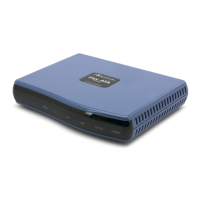User's Manual 242 Document #: LTRT-50614
MP-20x Multimedia Home Gateway
15.3 Configuring Port Forwarding
By default, the device blocks all external users from connecting to or communicating with
your network. Therefore, the system is safe from hackers who may try to intrude on the
network and damage it. However, you may want to expose your network to the Internet in
certain limited and controlled ways to enable some applications to work from the LAN
(game, voice and chat applications, for example) and to enable Internet access to servers
in the home network. The Port Forwarding feature supports both of these functionalities.
The 'Port Forwarding' screen lets you define the applications that require special handling
by the device. You must select the application's protocol and the local IP address of the
computer using or providing the service. If required, you can add new protocols in addition
to the most common ones provided by the device.
For example, to use an FTP application on one of your PCs, select 'FTP' from the list and
enter the local IP address or host name of the designated computer; all FTP-related data
arriving at the device from the Internet is then forwarded to the specified computer.
Similarly, to grant Internet users access to servers inside your home network, you must
identify each service that you want to provide and the PC that provides it. For example, to
host a Web server inside the home network you must select 'HTTP' from the list of
protocols and enter the local IP address or host name of the computer that hosts the Web
server. When an Internet user points her browser to the external IP address of the device,
it forwards the incoming HTTP request to the computer that is hosting the Web server.
Additionally, port forwarding enables you to redirect traffic to a different port instead of the
one to which it was designated. If for example you have a Web server running on your PC
on port 8080 and you want to grant access to this server to anyone who accesses the
device via HTTP, do the following:
Define a port forwarding rule for the HTTP service, with the PC's IP or host name.
Specify 8080 in the field 'Forward to Port'.
All incoming HTTP traffic is now forwarded to the PC running the Web server on port 8080.
When setting a port forwarding service, you must ensure that the port is not already in use
by another application, which may stop functioning. A common example is when using SIP
signaling in Voice over IP - the port used by the device's VoIP application (5060) is the
same port on which port forwarding is set for LAN SIP agents.
Note: Some applications, such as FTP, TFTP, PPTP and H323, require the support of
special specific Application Level Gateway (ALG) modules in order to work inside the
home network. Data packets associated with these applications contain information that
allows them to be routed correctly. An ALG is needed to handle these packets and ensure
that they reach their intended destinations. The device is equipped with a robust list of
ALG modules in order to enable maximum functionality in the home network.
The ALG is automatically assigned based on the destination port.

